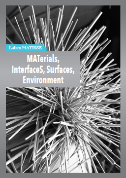Theory of X-ray circular dichroism and application to materials under pressure

Axe 5 - Matériaux en conditions extrêmes
Thèse de Nadejda Mas
Soutenue le lundi 11 décembre 2017 à 13h15
Salle de conférence de l'IMPMC
campus Jussieu, Tour 23, couloir 23-22, 4ème étage, salle 401
Laboratoire porteur
- Institut de minéralogie, de physique des matériaux et de cosmochimie
Porteur de projet : Philippe Sainctavit
Résumé
Mots-clés : Spectroscopie d'absorption près du seuil d'absorption de rayons X, Dichroïsme circulaire de rayons X, Calculs DFT, Magnétisme, Métaux de transition, Hautes-pressions
Le but principal de cette thèse était de calculer les spectres de dichroïsmes circulaire magnétique de rayons X au seuil K afin de fournir un outil pour interpréter les spectres expérimentaux, jusqu'ici très déroutants. La détermination du dichroïsme circulaire nécessite le calcul précis des spectres d'absorption des rayons X polarisés circulairement. Nous avons constaté que la théorie des perturbations semi-classique dépendante du temps, communément utilisée pour calculer les sections e‑caces d'absorption et de diusion, est incompatible à la fois, avec l'invariance de jauge et avec les descriptions semi-relativistes de la dynamique des électrons. Pour résoudre ces problèmes, on applique une transformation de Foldy-Wouthuysen aux sections e‑caces relativistes données par l'électrodynamique quantique. Ainsi, un nouveau terme d'interaction lumière-matière émerge, que nous avons appelé "spin-position". Une approche performante a été développée pour calculer la section e‑cace d'absorption afin d'obtenir le dichroïsme circulaire magnétique de rayons X (XMCD) et le dichroïsme circulaire naturel de rayons X (XNCD). La méthode numérique repose sur la théorie de la fonctionnelle de la densité en ondes planes avec des pseudopotentiels. Nous constatons que le terme couplant l'opérateur dipolaire électrique avec l'opérateur spin-position contribue significativement au XMCD au seuil K du fer, du nickel et du cobalt ferromagnétiques et nous l'expliquons grâce aux règles de somme. Nous avons également appliqué la méthode aux calculs du XMCD dans FeH et CrO2. Dans les deux cas, la combinaison de l'expérience et de la théorie conduit à un enrichissement mutuel.
Keywords : X-ray absorption near-edge spectrocopy, X-ray circular dichroism, DFT calculations, Magnetism, Transition metals, High-pressure
The main purpose of this thesis was to compute X-ray magnetic circular dichroism spectra at the K-edge in order to provide a tool to interpret the, so far very puzzling, experimental spectra. Computation of circular dichroism requires precise calculations of X-ray absorption spectra (XAS) for circularly polarized light. We have found that there is an incompatibility of the semi-classical time-dependent perturbation theory commonly used to calculate light absorption and scattering cross-sections with both gauge invariance and semi-relativistic descriptions of the electron dynamics. The problems are solved by applying a Foldy-Wouthuysen transformation to the fully relativistic cross-sections given by quantum electrodynamics. In the process, a new light-matter interaction term emerges, that we named the "spin-position" interaction. An e‑cient 1rst-principles approach was developed to compute the absorption cross-section in order to obtain X-ray magnetic circular dichroism (XMCD) and X-ray natural circular dichroism (XNCD). The numerical method relies on density-functional theory with plane waves and pseudopotentials. We found that the term coupling the electric dipole operator with the spinposition operator contributes significantly to the XMCD at the K-edge of ferromagnetic iron, cobalt, and nickel. We obtain a sum rule relating this term to the spin magnetic moment of the p states. We also applied the method to calculations of K-edge XMCD in FeH and CrO2. In both cases, the combination of experiment and theory leads to mutual enrichment.
Publications dans des revues internationales à comité de lecture
- N. Bouldi, N. J. Vollmers, C. G. Delpy-Laplanche, Y. Joly, A. Juhin et al.
X-ray Magnetic and Natural Circular Dichroism from first principles: Calculation of K- and L1-edge spectra
Physical Review B : Condensed matter and materials physics, American Physical Society, 2017, 96, pp.085123.
DOI : 10.1103/PhysRevB.96.085123
Ref HAL : hal-01515829v2 - Pré-publication
Nadejda Bouldi, Christian Brouder.
Gauge invariance and relativistic effects in photon absorption and scattering by matter
2017 - N. Daffé, M. Sikora, Nadejda Bouldi, V. Gavrilov, S. Neveu, F. Choueikani, V. Dupuis, M. Rovezzi, P. Sainctavit and A. Juhin,
Nanoscale distribution of magnetic anisotropies within bimagnetic core@shell nanoparticles dispersed in ferrofluid
Adv. Mater. Interfaces 2017, 4, 1700599 (2017).
https://doi.org/10.1002/admi.201700599 - P. Zimmermann, Nadejda Bouldi, M. O.J.Y. Hunault, J. M. Ablett, J.-P.Rue, B. Lebert, P. Sainctavit, F. M.F. de Groot and A. Juhin
Dipole and quadrupole transitions in the Cr K pre-edge of CrO2 separated with 1s2p Resonant Inelastic X-ray Scattering-Magnetic Circular Dichroism
J. Electron. Spectrosc. Relat. Phenom., Volume 222, 2018, Pages 74-87
https://doi.org/10.1016/j.elspec.2017.08.004. - Patric Zimmermann, Nadejda Bouldi, Myrtille O.J.Y. Hunault, Marcin Sikora, James Ablett et al.
1s2p Resonant Inelastic X-ray Scattering Magnetic Circular Dichroism as a probe for the local and non-local orbitals in CrO 2
Journal of Electron Spectroscopy and Related Phenomena, Elsevier, 2018, 222, pp.74 - 87.
DOI : 10.1016/j.elspec.2017.08.004
Ref HAL : hal-01708748v1
Proceedings
- Nadejda Bouldi and Ch. Brouder,"Relativistic effects and gauge invariance in photon absorption and scattering" (6 pages) In Multiple Scattering Theory for Spectroscopies, Springer Proceedings in Physics 204, 2018 Editors : Didier Sébilleau, Keisuke Hatada and Hubert Eberthttp://www.springer.com/us/book/9783319738109
International conferences, workshops and schools
Oral contributions in international conferences
- Sept. 2016 : International Conference on Advanced Materials Modelling (Rennes, France)
- May 2016 : General meeting of the GDR REST (Roscoff, France)
- Jan. 2016 : Users' Meeting 2016 - Soleil (Saint-Aubin, France)
- Sep. 2015 : XAFS16 Satellite Meeting : Aplication of XAFS to the Study of magnetic Materials (Stuttgart, Germany)
- Aug. 2015 : 16th International Conference on X-ray Absorption Fine Structure (XAFS16) (Karls-ruhe, Germany)
- June 2015 : 12th ETSF Young Researchers' Meeting (Paris, France)
Posters
- Feb. 2015 : ESRF Users Meeting 2015 (Grenoble, France)
- Jan. 2015 : Users' Meeting 2015 - Soleil (Saint-Aubin, France)
Tutorials in international schools
XSpectra : A tool for X-ray absorption spectra (XAS) calculations
Nadejda Bouldi and Guillaume Radtke
- Nov. 2016 : SOLEIL theory days
- Feb. 2016 : EUSpect winter school on core level spectroscopies (Ajdov²£ina, Slovenia)
Egalement dans la rubrique
- Etude structurale de B2O3 à l'aide de simulations de dynamique moléculaire incluant des potentiels polarisables
- Etude de la structure locale d'oxydes alcalins par diffusion Raman des rayons X
- Exploring the phase diagram of electrolyte solutions under extreme conditions
- L'Iode et le Xénon dans les magmas : Deux comportements différents
- Les mélanges (NH3/H2O) sous conditions extrêmes : une nouvelle voie pour l’élaboration de phases ioniques et superioniques « mixtes » ?
- Nanomatériaux à base de bore sous conditions extrêmes
- Partage du souffre et du platine entre un réservoir silicaté lors de la formation du noyau terrestre
- Propriétés magnétiques des supraconducteurs non conventionnels epsilon-Fe, FeSe, et Ca2CuO2Cl2 étudiés par diffusion des rayons X et des neutrons
- Reproduction expérimentale d'analogues de séismes mantelliques par déshydratation de l'antigorite et comparaison à des pseudotachylites naturelles
- Sound wave propagation and thermal relaxation in Fe and Fe-alloys at extreme conditions
- Synthèse de matière organique analogue à celle des météorites carbonées
MATISSE en chiffres
- 4 disciplines : Chimie, Physique, Sciences de la Terre, Patrimoine
- 400 permanents
Contact
Direction
Florence Babonneau
Administration
Communication
Emmanuel Sautjeau



